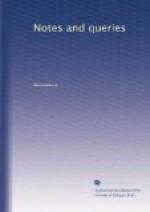ROBERT SNOW.
Coal Brandy (No. 22. p. 352.).—This is only a contraction of “coaled brandy,” that is, “burnt brandy,” and has no reference to the purity of the spirit. It was the “universal pectoral” of the last century; and more than once I have seen it prepared by “good housewives” and “croaking husbands” in the present, pretty much as directed in the following prescription. It is only necessary to remark, that the orthodox method of “coaling,” or setting the brandy on fire, was effected by dropping “a live coal” ("gleed”) or red-hot cinder into the brandy. This is copied from a leaf of paper, on the other side of which are written, in the hand of John Nourse, the great publisher of scientific books in his day, some errata in the first 8vo. edit. of Simsons’s Euclid, and hence may be referred to the year 1762. It was written evidently by some {457} “dropper-in,” who found “honest John” suffering from a severe cold, and upon the first piece of paper that came to hand. The writer’s caligraphy bespeaks age, and the punctuation and erasures show him to have been a literary man, and a careful though stilted writer. It is not, however, a hand of which I find any other exemplars amongst Nourse’s correspondence.
“Take two glasses of the best brandy, put them into a cup which may stand over the fire; have two long wires, and put an ounce of sugar-candy upon the wires, and set the brandy on fire. Let it burn till it is put out by itself, and drink it before you go to bed.
“To make it more pectoral,
take some rosemary and put it in the
brandy, infused for a whole
day, before you burn it.”
This is the fundamental element of all the quack medicines for “coughs, colds, catarrhs, and consumption,” from Ford’s “Balsam of Horehound” to Dr. Solomon’s “Balm of Gilead.”
T.S.D.
Shooter’s Hill, April 4.
Howkey or Horkey (No. 17. p. 263.).—Does the following passage from Sir Thomas Overbury’s Witty Descriptions of the Properties of sundry Persons, first published, I believe, in 1614, afford any clue to the etymology of this word? It occurs in the description of a Frankling or Yeoman:—
“He allows of honest pastime, and thinks not the bones of the dead anything bruised or the worse for it, though the country lasses dance in the church-yard after even-song. Rock-Monday, and the wake in summer shrovings, the wakeful catches on Christmas eve, the hoky or seed-cake, these he yearly keeps, yet holds them no relics of Popery.”
As I have not the book by me, and am only quoting from an extract, I am unable to give a more precise reference.
E.R.J.H.
Chancery Lane.
It may be possible further the purpose of the noble Querist as to the word Howkey or Horkey, if I state, that when in my boyhood I was accustomed to hear this word, it was pronounced as if spelt Hockey. As Howkey I should not have recognised it, nor hardly as Horkey.




